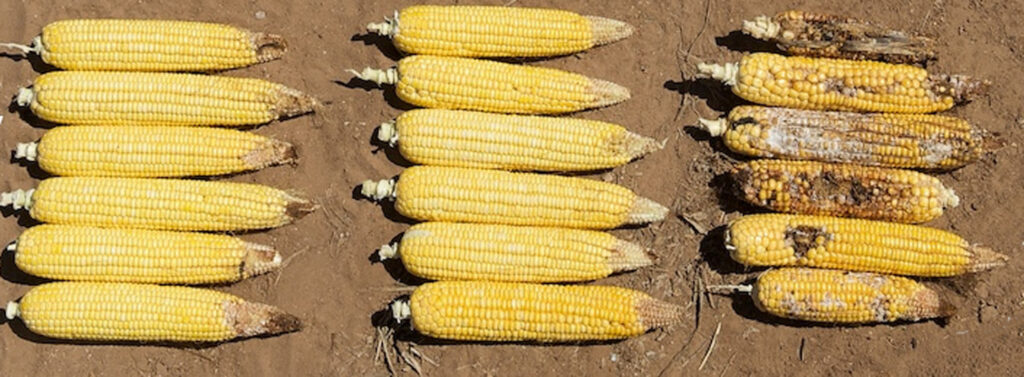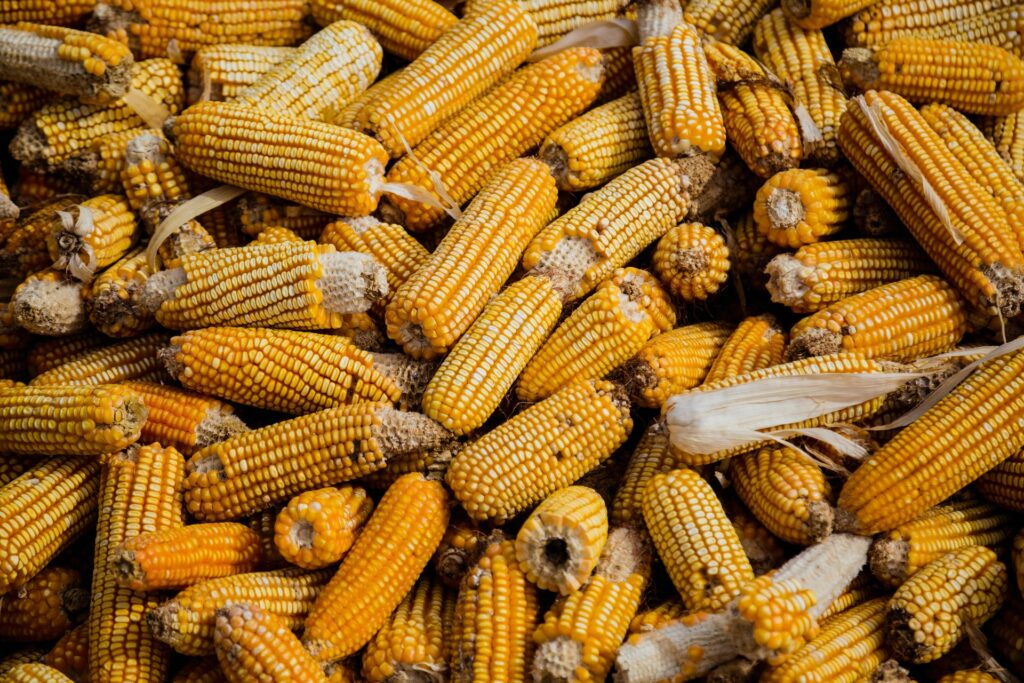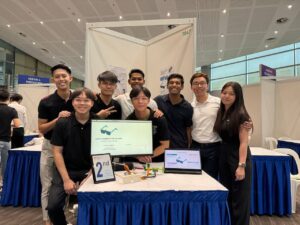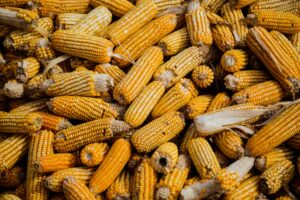We have previously talked about how genetically modifying food can solve our food crisis. However, genetic modification ain’t all rainbows and sunshine.
Impacts on the Environment
With the introduction of GMOs in agriculture, questions have been raised regarding their effects on soil and biodiversity. DNA can be transferred from one living thing to another and through the soil and may have consequences on non-target species (Food and Agriculture Organization, 2019). Some insects/pests may develop resistance to insect-resistant crops and loss of biodiversity.

A real-life example of this would be the GM Bacillus thuringiensis (Bt) corn. As farmers harvest their corn, they will find lepidopteran larvae (caterpillar) and coleopteran larvae which feed and live inside the corn (Richard. L & Kristina. A, 2012). To combat this problem, scientists created Bt corn. Bacillus thuringiensis is a bacterium that produces proteins which are deadly to some insects (Richard. L & Kristina. A, 2012). Bt maize was toxic to Monarch butterfly Larvae its population dropped as a result of its consumption of corn (Sears et al.,2001). Overuse of BT produced pests resistant to BT such as fall armyworm and African stem borer (Richard. L & Kristina. A, 2012). As a result, BT corn affected biodiversity. The Monarch butterfly’s population dropped and brought up a new breed of pests that were resistant to it. It solved one problem only to create another.
Social Impacts

As more GM foods are being accepted by society, the rate of suicides of farmers that produce these GM crops is also on the rise (The Daily Mail, 2008). Families are torn apart as a result. As stated by The Daily Mail (2008), Farmers had been convinced previously of huge harvests and income if they start farming with GM seeds. These farmers would borrow money to purchase land and seeds thinking that they could make enough profit to pay off their debt and obtain disposable income.
To prevent GM crops from affecting the environment and transferring their DNA, the crops have “terminator technology” to prevent the plants to produce seeds for reproduction according to an article from Informa Healthcare: Critical Reviews in Biotechnology (2015). Farmers had to continuously buy more GM seeds in order to produce more crops and these seeds require double the amount of water (The Daily Mail, 2008). With climate change, there was little to no harvest due to a lack of rain and droughts (National Geographic, 2019). Instead of producing harvests and profits, these farmers were drowned in debt. Knowing that they could not pay these debts, they committed suicide to end their sufferings.
Laws and Legislation
In order for GMOs to be safe and accepted by the public, it has to be lab tested and regulated by officials and governments. European Union has set an example by making it obligatory for Scientists to obtain consent from authorities along with detailed information, assessment reports, monitoring plans and disclosure of information and allowing time for the public to respond (Judgment of the Court: Fourth Chamber, 2009) to reduce the negative impacts of GMO.
In Singapore, we have the Genetic Modification Advisory Committee (GMAC) with 4 subcommittees to ensure public safety while maintaining a conducive environment for the commercial use of GMOs (GMAC, 2019). Their tasks include advising, approval, monitoring, disclosing information and many more. GMOs should be grown in labs or designated areas so that they can be controlled and minimise their repercussion and avoid abuse of this technology such as biowarfare.
Conclusion
GM could solve malnutrition in developing countries and our problems here in Singapore. We can reduce the rising number of people with genetic and chronic health issues through extensive research and the use of GMOs. Authorities, however, have to regulate to ensure that proper procedure is taken and provide transparency of information to ensure it is safe and supported by the public. GMOs will continue to advance and change the way we live for decades.
References
Andrew Malone (2008, November 3). The GM genocide: Thousands of Indian Farmers are Committing Suicide after using Genetically Modified Crops. The Daily Mail. Retrieved from https://www.dailymail.co.uk/news/article-1082559/The-GM-genocide-Thousands-Indian-farmers-committing-suicide-using-genetically-modified-crops.html
A.S Bawa, K.R Anilakumar (2013). Genetically modified foods: safety, risks and public concerns-a review. Retrieved from https://www.ncbi.nlm.nih.gov/pmc/articles/PMC3791249/
European Union Judgement of the Court (Fourth Chamber), Case C-552/07 (2009). Retrieved from http://curia.europa.eu/juris/document/document.jsf;jsessionid=9ea7d2dc30dbc3b29977a1134bcfb724c51ba52915a8.e34KaxiLc3qMb40Rch0SaxuMaNb0?text=&docid=72933&pageIndex=0&doclang=en&mode=lst&dir=&occ=first&part=1&cid=929369
Food and Agriculture Organization of United Nations (2001). GMOs and the Environment. Retrieved from http://www.fao.org/3/x9602e/x9602e07.htm#TopOfPage
Genetic Modification Advisory Committee (2013). The Singapore Biosafety Guidelines For Research On Genetically Modified Organisms (GMOs) Retrieved from https://www.gmac.sg/pdf/Research/Singapore%20Biosafety%20Guidelines%20for%20GMO%20Research_Jan%202013.pdf
Genetic Modification Advisory Committee (1999). Committee Set Up To Establish Biosafety Guidelines In Singapore For Genetically Modified Organisms. Retrieved from https://www.gmac.sg/News/1999/1999_05_11.html
Golden Rice Humanitarian Board (n.d). Vitamin A Deficiency-Related Disorders (VADD). Retrieved from http://www.goldenrice.org/Content3-Why/why1_vad.php
Goldern Rice Project (n.d). The Science Behind Golden Rice. Retrieved from http://www.goldenrice.org/Content2-How/how1_sci.php
HealthHub (n.d). Diabetes in Singapore. Retrieved from https://www.healthhub.sg/a-z/diseases-and-conditions/626/diabetes
Jane E. Brody (2018, April 23). Are G.M.O Safe? The New York Times. Retrieved from https://www.nytimes.com/2018/04/23/well/eat/are-gmo-foods-safe.html
Jillian.K (2018). Vitamin A: Benefits, Deficiency, Toxicity and More. Retrieved from https://www.healthline.com/nutrition/vitamin-a
Hossein.A, Hossein.M, Atry.S, Zeynab.J, Parisa.R, Philippe.D.M, Frank.W (2015). Genetically modified crops and small-scale farmers: Main opportunities and challenges [PDF File]. Retrieved from https://www.researchgate.net/publication/270580127_Genetically_modified_crops_and_small-scale_farmers_Main_opportunities_and_challenges
Library of Congress (2015). Restrictions on Genetically Modified Organisms: United States. Retrieved from https://www.loc.gov/law/help/restrictions-on-gmos/usa.php
Library of Congress (2015). Restrictions on Genetically Modified Organisms: European Union. Retrieved from https://www.loc.gov/law/help/restrictions-on-gmos/eu.php#Release
Lisa W. Foderaro (2019). Climate Change has Contributed to Droughts Since 1900-and may get worse. Retrieved from https://www.nationalgeographic.com/environment/2019/05/climate-change-linked-drought-past-century-via-tree-rings/
Mark K. Sears, Richard L. Hellmich, Diane E. Stanley-Horn, Karen S. Oberhauser, John M. Pleasants, Heather R. Mattila, Blair D. Siegfriedi & Galen P. Dively (2001). Impact of Bt pollen on Monarch Butterfly Populations: A Risk Assessment [PDF File]. Retrieved from https://www.researchgate.net/publication/11787810_Impact_of_Bt_corn_pollen_on_monarch_butterfly_populations_A_risk_assessment
Pellegrino, E., Bedini, S., Nuti, M., & Ercoli, L. (2018). Impact of genetically engineered maize on agronomic, environmental and toxicological traits: a meta-analysis of 21 years of field data. Retrieved from https://doi.org/10.1038/s41598-018-21284-2
United Nations (2015). UN projects world population to reach 8.5 billion by 2030, driven by growth in developing countries. Retrieved from https://www.un.org/sustainabledevelopment/blog/2015/07/un-projects-world-population-to-reach-8-5-billion-by-2030-driven-by-growth-in-developing-countries/
United Nations (n.d). Goal 2: Zero Hunger – United Nations Sustainable Development. Retrieved from https://www.un.org/sustainabledevelopment/hunger/
World Health Organization (n.d). Genes and Human Diseases. Retrieved from https://www.who.int/genomics/public/geneticdiseases/en/index3.html
World Health Organisation (2014). Frequently asked questions on genetically modified foods. Retrieved from https://www.who.int/foodsafety/areas_work/food-technology/faq-genetically-modified-food/en/
World Health Organization, United Nations Childrens Fund (2014). Global Prevalence of Vitamin A Deficiency [PDF File]. Retrieved from https://www.who.int/nutrition/publications/micronutrients/vitamin_a_deficiency/WHO_NUT_95.3/en/ (Original work published 1995)






